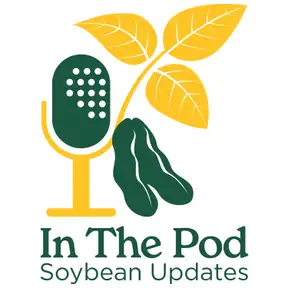09/18/25 Soybean Storage Challenges in a Shifting Market
You're listening to In The Pod, soybean updates, a weekly trek into the latest soybean information from NDSU Extension. There's a lot of talk about where North Dakota soybeans will go after this year's harvest. This impacts soybean prices, how to handle and store them. Jim Thompson, chairman of the North Dakota Soybean Council, is here to provide some clarity. Jim, before we get into the trade issues, can you talk about the evolution of soybeans in North Dakota?
Jim Thompson:Ever since soybeans have become a popular cash crop in North Dakota, the issue has always been, well, this is great. We can grow soybeans. I mean, we can grow really good soybeans. What do we do with them? Right? Because the traditional soybean producing states have always been down in the Corn Belt. Your Iowa, Illinois, Indiana, all those states. What do they all have in common? They have waterways. They have not only the Mississippi, they have all the tributaries of the Mississippi. So they have a way to get their crop to market quite efficiently. North Dakota is a little bit opposite of that. We're pretty landlocked, not a lot of big rivers flowing. In fact, the one that we have flows the wrong direction for soybeans delivery. So we've spent the last thirty to forty years developing this infrastructure of who's our big customer. It's Asia. That's where our beans need to go. So we've spent time and money and resources along with partners to get our beans to Pacific Northwest where there's lots of great facilities to load boats with beans and get them overseas. And then we've got these great local elevators that have kind of grown and become these shuttle loaders, these 110 car plus shuttle loaders where they can take a lot of beans and get them out to the West Coast and back. It's taken a long time to develop this as most markets do, but it's worked out really well for us, and this is what we've become accustomed to. With the current hiccup, it's thrown all producers in North Dakota, Kansas great big curveball of, k. Well, that's the way we've been doing it, but now we've gotta figure out a different way.
Bruce Sundeen:Let's talk about that hiccup. What's going on?
Jim Thompson:Without the trade program that we've kind of enjoyed with China, without that market, you're looking at 60% 50 to 60% of the crop grown soybeans specifically in North Dakota no longer have a home. We no longer have that trade partner to ship these beans off to at harvest time like we've been used to, and there's no other market that can replace nor is there a combination of markets that can take our beans like China did. Until we had the two crushed plants, 80% of the beans in North Dakota were exported, and they're exported via the PNW for the most part. Bring in two crushed plants, great. We still have roughly 50% of the whole beans that we need to get exported. Without that program in place, it creates a glut. And we're used to not storing soybeans and storing corn and delivering corn, you know, later on when freight allowed and and things kinda shook out down the line. Now we're being told we need to store beans and we need to store corn. And that's a problem that everybody kinda faces because we're just not built to store all of that commodity.
Bruce Sundeen:Jim, is there a solution or at least choices farmers might have?
Jim Thompson:There's options, and the options aren't great. Right? It's things that maybe we used to fill these little tiny grain bins on every farm, every farmstead that people owned. We'd fill a 2,500 bushel bin here and a 3,000 bushel bin there, but we kinda went away from that when we could get the crop off the field and deliver it at harvest time. And then we built our storage facilities around corn dryers and legs and big bins and things like that. The infrastructure for the bean markets basically focused to getting to the elevator and the elevator's having to worry about it. Well, elevators too, they're used to taking all that crop in, but getting it loaded on a train, turning those bins over and getting ready for corn harvest. It falls back to the producer now. We're gonna fill these small bins. We may be putting them in piles. We may be putting them in grain bags. We may be putting them in quonsets, or are we going to do something different? Maybe we'll put those beans in our big bins and leave the corn stand or put the corn on the ground. What's the lesser of two evils, if you will? So there's a lot changing every day. There's a mindset of, well, you know, I used to do that, but I'm never gonna do that again. Well, you're gonna have to get out your comfort zone a little bit and and decide what it is that's gonna be best for you. And another solution has been a lot of the elevators have decided, well, we're gonna have to put something on the ground as well. So a lot of elevators have invested in a little bit more permanent temporary storage, if you will.
Bruce Sundeen:Thanks, Jim. Our guest has been Jim Thompson, chairman of the North Dakota Soybean Council. You're listening to In the Pod, soybean updates, a weekly trek into the latest soybean information from NDSU Extension supported by the North Dakota Soybean Council.

